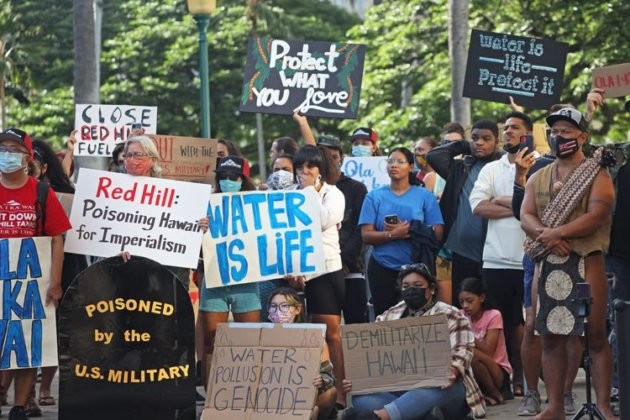Defueling Red Hill Is Not Enough: It’s Time to Demilitarize the Asia-Pacific
By
Christian Ephriam
Posted:
|
Military & Security

Photo by Jason Lees/ for Ka Wai Ola
This fall, organizers with the O’ahu water protectors in Hawai’i made the long trek to the White House to demand an immediate shut down of the Red Hill bulk fuel storage facility amidst growing frustrations with the Department of Defense’s current plans to completely defuel the facility by July 2024.
In November of 2021, thousands of gallons of jet fuel stored at the facility began to leak into Oahu’s largest water supply, contaminating the drinking water of nearly 100,000 residents. A survey of residents whose water had been contaminated conducted by the CDC found that 87% of respondents reported worsening health symptoms following the contamination, and that over one-third of said respondents needed medical treatment.
Despite Secretary of Defense Lloyd Austin’s commitment to being a good ‘steward of the land’ moving forward, many Hawaiians continue to view the U.S. military with extreme distrust—and with good reason. Organizers and community members in Hawai’i have been raising safety concerns regarding Red Hill for years; however, these concerns were routinely ignored until it was too late. An investigation conducted by Rear Adm. Christopher Cavanaugh notes a damning series of failures contributing to the disaster including reduced oversight of the facility, discrepancies in reporting, and a “lack of critical thinking, intellectual rigor, and self-assessment by key leaders at decisive moments.”
The Red Hill disaster is only one of a multitude of instances of the U.S. military causing extreme harm to both the environment and people of Hawai’i and throughout the rest of the Asia-Pacific. This Summer’s RIMPAC games, the largest maritime ware exercises in the world, is a prime example of this. Although RIMPAC’s spokesperson assured native Hawaiians that the military would be “good stewards of this environment” and that active efforts were being made to protect training grounds, this would all prove to be lip-service in the end, as the use of live gunfire, missiles, and sonar continue to have adverse effects on marine wildlife.
Even more alarming are the increased instances of sexual violence that accompany such military presence. The Hawai’i State Commission on the Status of Women has found that “Major events such as RIMPAC create a significant risk of commercial sexual exploitation to women and girls in Hawai’i” with “Native Hawaiian, immigrant, and LGBTQ persons” being particulrly vulnerable to prostitution and sex trafficking.”
While this trend is disturbing, it is not at all unique. The Okinawa-based organization, Okinawan Women Act Against Military Violence, have arrived at similar conclusions regarding the U.S. military’s role in sexual exploitation, recording over 350 sex crimes in their report on U.S. Military Crimes in Japan post-World War II.
Roughly 4,000 miles off the coast of Hawai’i in another U.S. occupied territory, Guam, we can find similar trends of environmental degradation and disregard for the livelihood of natives on the part of the U.S. military. Despite persistent efforts from indigenous activists on the island to demilitarize and to pursue alternative political statuses (full independence being among them), the Department of Defense has made it clear that it will continue to use Guam for its own political agenda regardless of the negative impacts. The 2023 NDAA has earmarked roughly $1 billion for the integration of an air and missile defense infrastructure on the island. Additionally, construction began last month for live-fire training ranges and support facilities very close to the Northern Guam Lens Aquifer, the primary source of drinking water on the island – a harrowing sign of what damage may come in light of what happened at Red Hill.
The Guam construction project, which will uproot roughly 200 acres of forest housing numerous endangered species, is, ironically, part of an agreement between the U.S. and Japanese Governments to relocate 5,000 marines from Okinawa to Guam in response to anti-militarist protests in Okinawa. While this is a win for residents and organizers in Okinawa, the fight is definitely not over, as the U.S. military has made it clear that they will prioritize their own interests over the health and wellbeing of local populations wherever they go. Major General Dennis Larsen is even on record saying that Guam is “not Okinawa” and that “we can do what we want here, and make huge investments without fear of being thrown out…” The United Nations has critiqued the U.S.’ treatment of the Chamorro people in Guam, citing lack of “free, prior and informed consent” regarding military expansion efforts.
The U.S. military has ignored the voices of impacted people and the international community for long enough. It’s time for progressives to add our voices and demand demilitarization so that people in Hawai’i, Guam, Okinawa and elsewhere can live free from the environmental and human degradations imposed by the U.S. military.